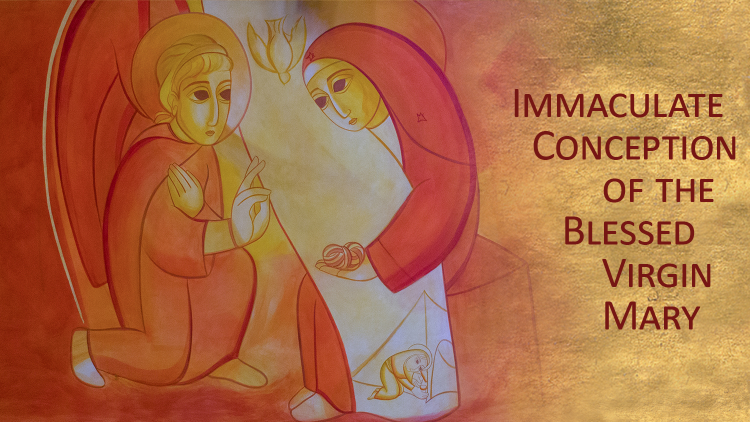
Solemnity of the Immaculate Conception of the Blessed Virgin Mary
Nine months before the Feast of the Nativity of the Blessed Virgin Mary (8 September), the Church celebrates the Solemnity of her Immaculate Conception. The Feast was approved in 1476 by Pope Sixtus IV. It was extended to the universal Church by Pope Clement XI in 1708.
Acknowledging the belief held for centuries by the Fathers and Doctors of the Church, of councils and his predecessors, Pope Pius IX solemnly proclaimed the Dogma of the Immaculate Conception in 1854: “We declare, pronounce, and define that the doctrine which holds that the most Blessed Virgin Mary, in the first instance of her conception, by a singular grace and privilege granted by Almighty God, in view of the merits of Jesus Christ, the Savior of the human race, was preserved free from all stain of original sin” (Ineffabilis Deus, 1854)
The angel Gabriel was sent from God to a town of Galilee called Nazareth, to a virgin betrothed to a man named Joseph, of the house of David, and the virgin’s name was Mary. And coming to her, he said, “Hail, full of grace! The Lord is with you.” But she was greatly troubled at what was said and pondered what sort of greeting this might be. Then the angel said to her, “Do not be afraid, Mary, for you have found favor with God. Behold, you will conceive in your womb and bear a son, and you shall name him Jesus. He will be great and will be called Son of the Most High, and the Lord God will give him the throne of David his father, and he will rule over the house of Jacob forever, and of his Kingdom there will be no end.” But Mary said to the angel, “How can this be, since I have no relations with a man?” And the angel said to her in reply, “The Holy Spirit will come upon you, and the power of the Most High will overshadow you. Therefore the child to be born will be called holy, the Son of God. And behold, Elizabeth, your relative, has also conceived a son in her old age, and this is the sixth month for her who was called barren; for nothing will be impossible for God.” Mary said, “Behold, I am the handmaid of the Lord. May it be done to me according to your word.” Then the angel departed from her (Lk. 1:26-38).
A dream of love
The Gospel text is preceded by the Letter to the Ephesians (1:3ff.) which the liturgy proposes as the Second Reading. It is a hymn of praise, glory and blessing that extols God’s “design” for humanity: Blessed be the God and Father of our Lord Jesus Christ, who has blessed us in Christ with every spiritual blessing… he chose us in him, before the foundation of the world, to be holy and without blemish before him. In love he destined us for adoption to himself through Jesus Christ”. This dream, this project, finds its model in Mary: the holy and immaculate one.
A shattered dream
That dream was shattered by Adam and Eve’s sin. This is presented in the liturgy through the First Reading. God’s dream always involved the freedom of man and woman even to say no.
Mary makes the dream alive again
With Mary’s “yes”, God’s original dream is revived. The “ground” is prepared so that His only-begotten Son, Jesus, might become man in a woman’s womb. Her “yes” comes after a moment of hesitation, bewilderment, but in the end, she assents because to Love that makes a request, one cannot but respond with a love that makes oneself available. Mary, the one who is full of grace, the one who is completely fair, completely pure, all holy, in her shines the beauty of God. She is the masterpiece of God’s love.
Everyone like her
But we have all been predestined, we have all been filled with every blessing, we have all been chosen to be holy and immaculate. We do not only “admire” the Virgin Mary, therefore, with tenderness and awe. We are also asked to “imitate” her so that God’s beauty might shine on the earth thanks to the many “yesses” that men and women continue to say today after the example and intercession of Mary, the Immaculate One.
Prayer
Virgin most holy and immaculate,
to you, the honor of our people,
and the loving protector of our city,
do we turn with loving trust.
You are all-beautiful, O Mary!
In you there is no sin.
Awaken in all of us a renewed desire for holiness:
May the splendor of truth shine forth in our words,
the song of charity resound in our works,
purity and chastity abide in our hearts and bodies,
and the full beauty of the Gospel be evident in our lives.
You are all-beautiful, O Mary!
In you the Word of God became flesh.
Help us always to heed the Lord’s voice:
May we never be indifferent to the cry of the poor,
or untouched by the sufferings of the sick and those in need;
may we be sensitive to the loneliness of the elderly and the vulnerability of children,
and always love and cherish the life of every human being.
You are all-beautiful, O Mary!
In you is the fullness of joy born of life with God.
Help us never to forget the meaning of our earthly journey:
May the kindly light of faith illumine our days,
the comforting power of hope direct our steps,
the contagious warmth of love stir our hearts;
and may our gaze be fixed on God, in whom true joy is found.
You are all-beautiful, O Mary!
Hear our prayer, graciously hear our plea:
May the beauty of God’s merciful love in Jesus abide in our hearts,
and may this divine beauty save us, our city and the entire world.
Amen.
(Pope Francis)








